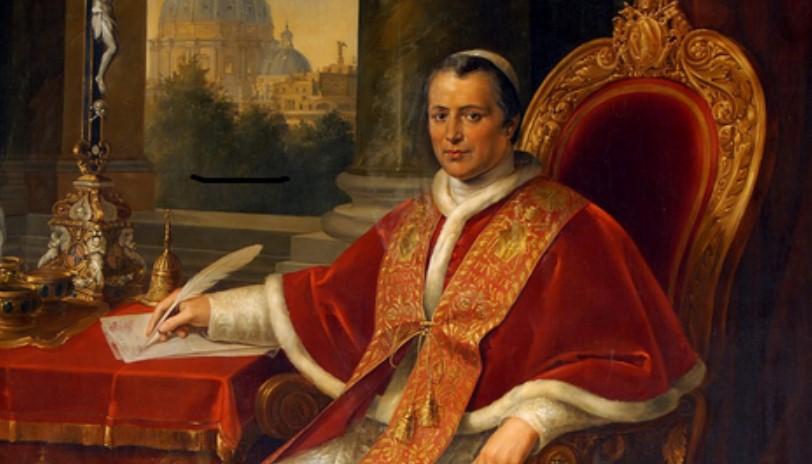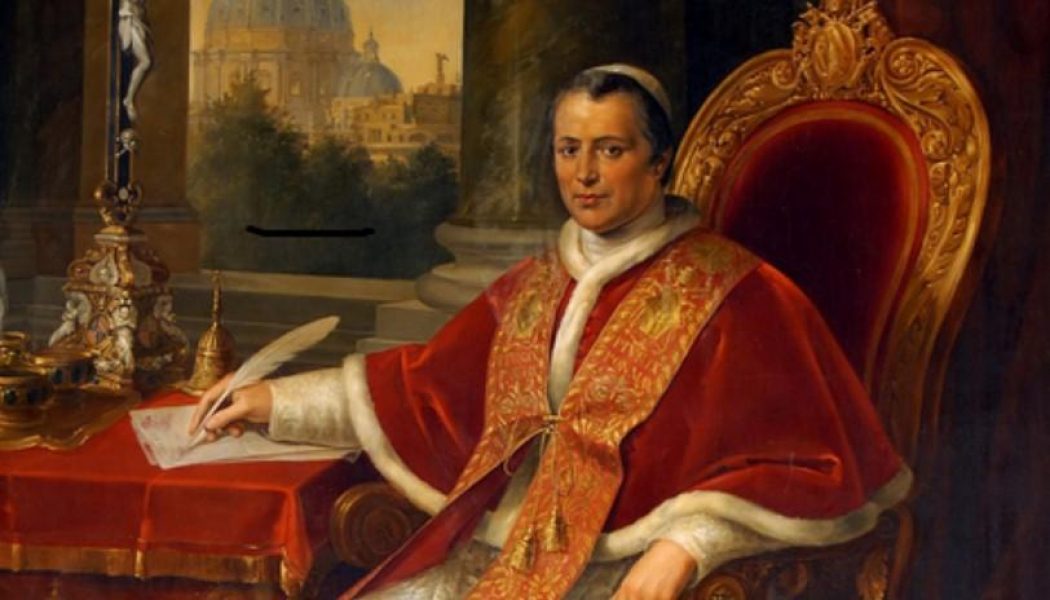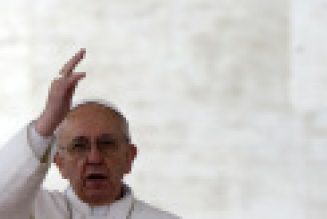
The Pope Who Would Be King: The Exile of Pius IX and the Emergence of Modern Europe
by David Kertzer
Random House, 2018
xxx + 474 pages
Historian David Kertzer made a name for himself with his 1997 book The Kidnapping of Edgardo Mortara. The book covers the until then rarely mentioned case of an Italian Jewish boy who was illicitly baptized by the housekeeper and then kidnapped in 1858 by Papal State authorities on the grounds that Jews in the Papal States could not be permitted to raise a Christian child.
Because so few books or in-depth articles have been written on the topic in English, Kertzer now enjoys a position as perhaps the preeminent expert on the case. This is no small thing, since a number of filmmakers—including Steven Spielberg—have expressed interest in dramatizing the Mortara case on film. The film project—explicitly based on Kertzer’s book—was still moving forward as of February of this year.
There’s an important lesson here for historians: if you can find an obscure but compelling historical episode to specialize in, it might pay off in a big way.
Since the success of the Mortara book, Kertzer has not strayed far from the subject matter. He has written a number of books over the past twenty years combining the topics of Jews, popes, and the modern Italian state.
With his most recent book, The Pope Who Would Be King (2018), Kertzer returns to the topic of the late Papal States and of the man who ruled at the time of the Mortara kidnapping: Pope Pius IX, a.k.a. “Pio Nono.”
As with the Mortara book, Kertzer once again focuses on a topic that is rarely examined at any length in the English language. This time it is the internal politics of the Papal States and how those politics influenced the regime’s relations with the great powers of Europe.
When it comes to relating the basic facts of the events surrounding the Papal States in the mid-nineteenth century, it is difficult to find much fault with Kertzer’s work. As we shall see, however, Kertzer’s interpretations of these facts ignore important context, and he falls into the trap of repeating a variety of myths about medieval government and “Enlightenment” regimes.
The Papal States and the War against Liberal Reformers
The setting itself is exciting, and Kertzer focuses most of his narrative on the events around the year 1848. This was a year of revolutions, upheavals, rebellions, and regime change in Europe. France, Austria, Denmark, and the German Confederation were all caught up in it. The papal regime most certainly did not escape from this untouched: by early 1849, the pope had fled Rome, and a new democratic, constitutionalist Roman Republic was declared in his absence.
Things hadn’t started out that way for Pio Nono. Although viewed as a pope “of the people” in the early days of his rule, Pius IX quickly soured on the liberal reformers once it became apparent they were going to keep demanding the same reforms enjoyed under the relatively liberal regimes elsewhere in Europe. The middle classes and working classes of the Papal States, for example, were demanding a constitution with some form of representative government, freedom of speech, and freedom of assembly. Most of all, these reformers wanted reforms to the legal systems of the Papal States which had long been regarded as inefficient and overly punitive for small crimes while failing to address serious crime.
On these matters—in part because the legal system was heavily dominated by clergy—Pius resisted. The upper classes of the Papal States—dominated by wealthy cardinals who were much more conservative than the pope—dug in their heels in opposition to any reform. Pius convinced himself that while liberalism may have worked in other places like England or France, the Italians were incapable of self-government. As Pius explained to a French diplomat in 1849, “[T]he Italian peoples are not suited for representative institutions. They are not yet sufficiently educated … [but] the time will come when they will be capable of having, like others, a regime that offers freedoms.”
Many within the Papal States apparently disagreed, and the pope was stripped of his political “temporal” powers in February 1849.
Kertzer goes on to describe how Pio Nono subsequently set up his court in exile in the Kingdom of Naples, and how he conspired with France, Spain, and Austria to retake his throne in Rome.
It is in recounting this story, complete with colorful descriptions of various cardinals, diplomats, and heads of state that Kertzer shines. The storytelling is engaging, and the timelines are clear. At the center of it all, of course, is Pio Nono himself, toward whom Kertzer is not unsympathetic. Pius is portrayed in a manner similar to how others have portrayed him over the years: a man more concerned with theological matters than matters of state, and as a figure of personal piety who led an austere lifestyle.
When it came to matters of state, however, Pius often exhibited a spirit of petulance and of one who was in over his head.
Like so many other monarchs and aristocrats of the nineteenth century who found themselves deposed or in the midst of revolution, Pius was shocked to discover that he was not universally loved by his subjects. He viewed demands for political reforms in the Papal States as cases of personal betrayal. He complained that “[n]ever has a Pope or sovereign been more miserable than me,” but was, according to Kertzer, most pained by the apparent fact that after his exile “not a single Roman had lifted a finger in defense of his rule.”
Pio Nono thus became convinced that he would require the assistance of foreign armies to reinstall him as the worldly king of central Italy. He invited the Austrian army to retake the northern portions of the Papal States, centered in Bologna, the second city of the Papal States. The French, on the other hand, were to retake Rome itself. The Austrians, of course, were happy to expand their influence in northeastern Italy. For the French, the political rationale was twofold. The French expedition would allow conservative French politicians to pander to their Catholic voters. On the other hand, the republican French regime would demand that the pope recognize basic freedoms and allow for constitutional government.
Neither the Austrians nor the French—or, apparently, the pope—had many qualms about shedding Roman blood. The Austrians shelled and besieged Bologna. The French—reluctant to shell or set afire a city filled with many of the most ancient treasures of Christendom—focused their artillery on the Roman walls. Nonetheless, many shells missed, and as many as eighteen hundred Romans were killed in the siege. This, of course, only served to radicalize many moderate Romans against any return to papal rule, with or without reforms.
The scheme worked. The Austrians reestablished rule in the northern Papal States, and the French put Pius back on his throne. In the end, however, it was the pope who was playing the French, and the pope refused to make any concessions to the liberals. The French nonetheless continued to occupy Rome—and thus keep the pope on his throne—out of fear the Austrians would seize Rome in France’s stead.
The Papal States and Absolutism in Context
These basic facts are not much in dispute, and Kertzer skillfully compiles them.
Indeed, a review of other works on the Papal States suggests a picture that is hardly flattering for papal rule. The Papal States were economically backward and industrialization was far behind other European polities. Thus, poverty was more widespread and rebellion was relatively common. The common people were often at the mercy of vindictive local despots. Crime was often rampant. In its final decades, the papal regime was increasingly in debt, largely as a result of an enormous, dysfunctional, and burdensome welfare state.
Yet these facts also contradict Kertzer’s interpretation of the realities of papal rule. Kertzer attempts to portray the rule of the popes as one of unrestrained absolutism with foundations in the Middle Ages. The Papal States, we are to believe, comprised a unified police state which answered to a single undisputed sovereign and was rooted in a “medieval vision” of “divine rule.”
On this, Kertzer veers badly, of course. Not only did the popes never achieve absolute rule within the Papal States, but the Papal States were not the model for absolutism elsewhere in Europe. Nor was the absolutist model a legacy of the Catholic Middle Ages.
A Terrible Model for Aspiring Absolutists
As the name implies, the Papal States were never one unified polity. They were, rather, a patchwork of local “states” controlled by the nobility and other “elites” such as wealthy urban professionals and landed commoners.
On a day-to-day basis, the lack of direct papal control could be seen in the administration of the legal system.
As noted by historian Steven Hughes, the popes had long attempted to implement their own brand of direct justice but repeatedly failed. For many years, the popes employed a police force, known as “sbirri,” who would become known for their corruption and disregard for local customs and interests. For the local aristocrats and other wealthy elites within the Papal States, however, papal rule was an inconvenience to be flouted. Indeed, in many areas, “the better families” instituted their own brand of law and hired criminal gangs to protect local interests. These gangs, or “biricchini,” Hughes tells us, “always lived on the fringes of legality.” Moreover, targets of papal justice within all classes might find refuge and immunity from papal law with local nobles, who offered immunity in return for loyalty from local commoners. Thus, Hughes concludes, “the central regime could count on little support from the upper echelons of society.”
On top of this was the fact that crime and disorder were a sad reality of life in many areas. Hughes notes that opposition to papal rule was fueled at least as much by the perceived abuses of “absolutist” popes as by a failure to keep law and order. In other words, the papal regime may have been viewed as abusive, but the more damning indictment was likely the fact that it was regarded as being of little use in helping secure the lives and property of ordinary people. Given its mounting debt, the Papal States were increasingly prone to failure by the time of Pius IX.
There is no doubt that the papal regime wished to become an absolute monarchy, “yet the reality of the Pope’s power in no way matched the pretense.”
In spite of this, Pius and his supporters did apparently embrace a political fiction that the pope’s rule was both absolute and necessary. On this, Kertzer quotes the conservative Austrian diplomat Klemens von Metternich: “The Papal States exist … and their existence is both a social and political necessity.” After all, the absolutists agreed, “how could rulers justify their own regimes as divinely ordained if the pope’s heavenly mandate were cast in doubt?”
This may have been effective monarchist propaganda, but it had little foundation in historical experience. After all, the Papal States did not even exist until the eighth century, and monarchs had somehow come up with ways to justify their regimes until that time. Kertzer also errs in attempting to connect the absolutist model to the Middle Ages. He plays fast and loose with terms like “divine rule,” and attributes the latter concept to what he calls a “medieval vision” in which monarchs presumably rule with absolute power.
Yet the medieval reality was one in which monarchs tended to be far weaker, and states far more decentralized, than was the case under the absolute rulers of Renaissance and modern Europe. In fact, political rule in the Middle Ages was often characterized by hearty opposition to absolute rule, complete with parliaments in a number of budding European states. The general rise of powerful regimes unimpeded by legislatures, local nobles, or independent cities is a relatively modern and postmedieval development in Europe. Absolutism is not even especially connected to Catholic monarchs, as was made clear by the rise of Tudor absolutism in England.
Nor did the church necessarily view nonmonarchical institutions with suspicion. Indeed, as Lord Acton points out in his essay “Political Thoughts on the Church,” the papacy—and countless other ecclesiastical institutions—can be found on numerous occasions to have supported “the people” in various forms. This was usually done to counter reigning monarchs thought to be injurious to the church.
Napoleon as Catalyst for a Modernized Papal Regime
Further illustrating this point: the papal regime was greatly augmented in its final decades not by a return to medievalism, but by Napoleon’s annexation of he Papal States in 1809. As Hughes notes, it was Napoleon’s ultramodern and bureaucratic regime that did the most to reduce the decentralism left behind by medieval institutions. It was the French state that provided “centralization backed up by Napoleon’s bayonets,” set the stage for “the destruction of the old patterns of privilege,” and allowed the papal regime to attempt a greater consolidation of power.
By the time of Pio Nono, however, this absolutist transformation had only been incomplete and haphazard. The general public and the aristocracy both remained highly suspicious of papal police and bureaucrats, and the popes, at least outside Rome itself, never achieved absolutist rule.
Although Kertzer provides us with a readable and helpful case study on the nineteenth-century Papal States, his larger conclusions about Catholic notions or monarchy or the historical origins of the papal regime’s instability are quite superficial. The ideological framework underlying The Pope Who Would Be King ought to be taken with a big grain of salt.
Join Our Telegram Group : Salvation & Prosperity







![Los Angeles DA George Gascon violates key policy in Bishop O’Connell murder case; “doesn’t know basic ethical rules or doesn’t care” [warning: autoplay video]…](https://salvationprosperity.net/wp-content/uploads/2023/03/los-angeles-da-george-gascon-violates-key-policy-in-bishop-oconnell-murder-case-doesnt-know-basic-ethical-rules-or-doesnt-care-warning-autoplay-video-327x219.png)
